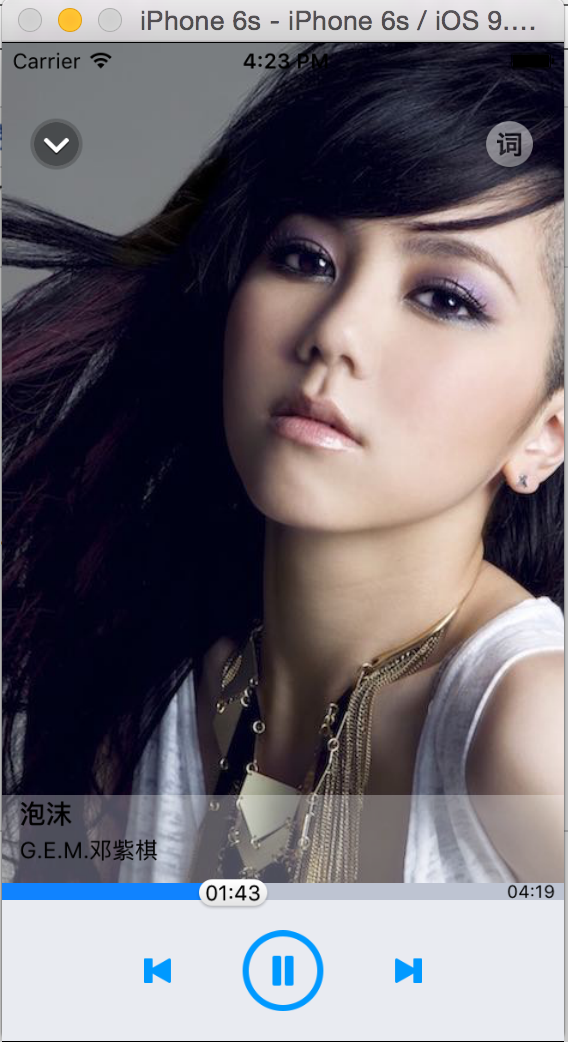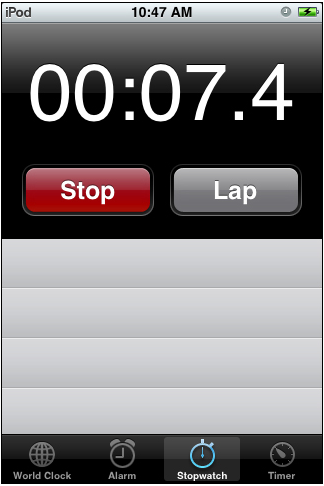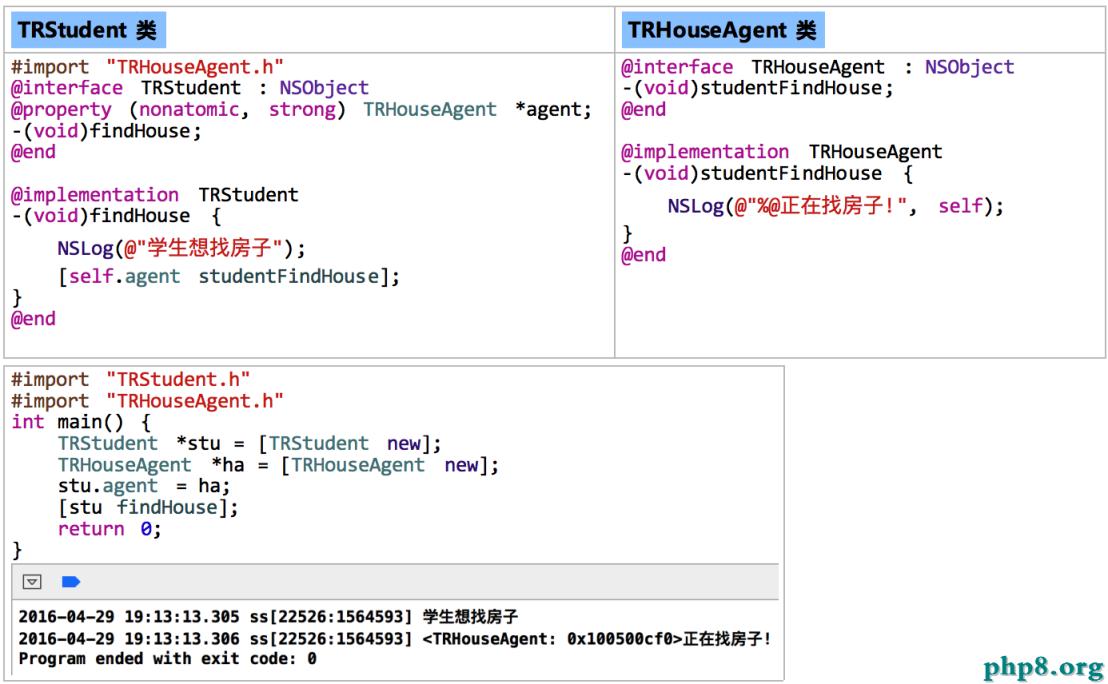ios開發:一個音樂播放器的設計與實現案例
這個Demo,關於歌曲播放的主要功能都實現了的。下一曲、上一曲,暫停,根據歌曲的播放進度動態滾動歌詞,將當前正在播放的歌詞放大顯示,拖動進度條,歌曲跟著變化,並且使用Time Profiler進行了優化,還使用XCTest對幾個主要的類進行了單元測試。
已經經過真機調試,在真機上可以後台播放音樂,並且鎖屏時,顯示一些主要的歌曲信息。
根據歌曲的播放來顯示對應歌詞的。用UITableView來顯示歌詞,可以手動滾動界面查看後面或者前面的歌詞。
並且,當拖動進度條,歌詞也會隨之變化,下一曲、上一曲依然是可以使用的。
代碼分析:
准備階段,先是寫了一個音頻播放的單例,用這個單例來播放這個demo中的音樂文件,代碼如下:
#import <Foundation/Foundation.h>
#import <AVFoundation/AVFoundation.h>
@interface ZYAudioManager : NSObject
+ (instancetype)defaultManager;
//播放音樂
- (AVAudioPlayer *)playingMusic:(NSString *)filename;
- (void)pauseMusic:(NSString *)filename;
- (void)stopMusic:(NSString *)filename;
//播放音效
- (void)playSound:(NSString *)filename;
- (void)disposeSound:(NSString *)filename;
@end
#import "ZYAudioManager.h"
@interface ZYAudioManager ()
@property (nonatomic, strong) NSMutableDictionary *musicPlayers;
@property (nonatomic, strong) NSMutableDictionary *soundIDs;
@end
static ZYAudioManager *_instance = nil;
@implementation ZYAudioManager
+ (void)initialize
{
// 音頻會話
AVAudioSession *session = [AVAudioSession sharedInstance];
// 設置會話類型(播放類型、播放模式,會自動停止其他音樂的播放)
[session setCategory:AVAudioSessionCategoryPlayback error:nil];
// 激活會話
[session setActive:YES error:nil];
}
+ (instancetype)defaultManager
{
static dispatch_once_t onceToken;
dispatch_once(&onceToken, ^{
_instance = [[self alloc] init];
});
return _instance;
}
- (instancetype)init
{
__block ZYAudioManager *temp = self;
static dispatch_once_t onceToken;
dispatch_once(&onceToken, ^{
if ((temp = [super init]) != nil) {
_musicPlayers = [NSMutableDictionary dictionary];
_soundIDs = [NSMutableDictionary dictionary];
}
});
self = temp;
return self;
}
+ (instancetype)allocWithZone:(struct _NSZone *)zone
{
static dispatch_once_t onceToken;
dispatch_once(&onceToken, ^{
_instance = [super allocWithZone:zone];
});
return _instance;
}
//播放音樂
- (AVAudioPlayer *)playingMusic:(NSString *)filename
{
if (filename == nil || filename.length == 0) return nil;
AVAudioPlayer *player = self.musicPlayers[filename]; //先查詢對象是否緩存了
if (!player) {
NSURL *url = [[NSBundle mainBundle] URLForResource:filename withExtension:nil];
if (!url) return nil;
player = [[AVAudioPlayer alloc] initWithContentsOfURL:url error:nil];
if (![player prepareToPlay]) return nil;
self.musicPlayers[filename] = player; //對象是最新創建的,那麼對它進行一次緩存
}
if (![player isPlaying]) { //如果沒有正在播放,那麼開始播放,如果正在播放,那麼不需要改變什麼
[player play];
}
return player;
}
- (void)pauseMusic:(NSString *)filename
{
if (filename == nil || filename.length == 0) return;
AVAudioPlayer *player = self.musicPlayers[filename];
if ([player isPlaying]) {
[player pause];
}
}
- (void)stopMusic:(NSString *)filename
{
if (filename == nil || filename.length == 0) return;
AVAudioPlayer *player = self.musicPlayers[filename];
[player stop];
[self.musicPlayers removeObjectForKey:filename];
}
//播放音效
- (void)playSound:(NSString *)filename
{
if (!filename) return;
//取出對應的音效ID
SystemSoundID soundID = (int)[self.soundIDs[filename] unsignedLongValue];
if (!soundID) {
NSURL *url = [[NSBundle mainBundle] URLForResource:filename withExtension:nil];
if (!url) return;
AudioServicesCreateSystemSoundID((__bridge CFURLRef)(url), &soundID);
self.soundIDs[filename] = @(soundID);
}
// 播放
AudioServicesPlaySystemSound(soundID);
}
//摧毀音效
- (void)disposeSound:(NSString *)filename
{
if (!filename) return;
SystemSoundID soundID = (int)[self.soundIDs[filename] unsignedLongValue];
if (soundID) {
AudioServicesDisposeSystemSoundID(soundID);
[self.soundIDs removeObjectForKey:filename]; //音效被摧毀,那麼對應的對象應該從緩存中移除
}
}
@end
就是一個單例的設計,並沒有多大難度。我是用了一個字典來裝播放過的歌曲了,這樣如果是暫停了,然後再開始播放,就直接在緩存中加載即可。但是如果不注意,在 stopMusic:(NSString *)fileName 這個方法裡面,不從字典中移除掉已經停止播放的歌曲,那麼你下再播放這首歌的時候,就會在原先播放的進度上繼續播放。在編碼過程中,我就遇到了這個Bug,然後發現,在切換歌曲(上一曲、下一曲)的時候,我調用的是stopMusic方法,但由於我沒有從字典中將它移除,而導致它總是從上一次的進度開始播放,而不是從頭開始播放。
如果在真機上想要後台播放歌曲,除了在appDelegate以及plist裡面做相應操作之外,還得將播放模式設置為:AVAudioSessionCategoryPlayback。特別需要注意這裡,我在模擬器上調試的時候,沒有設置這種模式也是可以進行後台播放的,但是在真機上卻不行了。後來在StackOverFlow上找到了對應的答案,需要設置播放模式。
這個單例類,在整個demo中是至關重要的,要保證它是沒有錯誤的,所以我寫了這個類的XCTest進行單元測試,代碼如下:
#import <XCTest/XCTest.h>
#import "ZYAudioManager.h"
#import <AVFoundation/AVFoundation.h>
@interface ZYAudioManagerTests : XCTestCase
@property (nonatomic, strong) AVAudioPlayer *player;
@end
static NSString *_fileName = @"10405520.mp3";
@implementation ZYAudioManagerTests
- (void)setUp {
[super setUp];
// Put setup code here. This method is called before the invocation of each test method in the class.
}
- (void)tearDown {
// Put teardown code here. This method is called after the invocation of each test method in the class.
[super tearDown];
}
- (void)testExample {
// This is an example of a functional test case.
// Use XCTAssert and related functions to verify your tests produce the correct results.
}
/**
* 測試是否為單例,要在並發條件下測試
*/
- (void)testAudioManagerSingle
{
NSMutableArray *managers = [NSMutableArray array];
dispatch_group_t group = dispatch_group_create();
dispatch_group_async(group, dispatch_get_global_queue(DISPATCH_QUEUE_PRIORITY_DEFAULT, 0), ^{
ZYAudioManager *tempManager = [[ZYAudioManager alloc] init];
[managers addObject:tempManager];
});
dispatch_group_async(group, dispatch_get_global_queue(DISPATCH_QUEUE_PRIORITY_DEFAULT, 0), ^{
ZYAudioManager *tempManager = [[ZYAudioManager alloc] init];
[managers addObject:tempManager];
});
dispatch_group_async(group, dispatch_get_global_queue(DISPATCH_QUEUE_PRIORITY_DEFAULT, 0), ^{
ZYAudioManager *tempManager = [[ZYAudioManager alloc] init];
[managers addObject:tempManager];
});
dispatch_group_async(group, dispatch_get_global_queue(DISPATCH_QUEUE_PRIORITY_DEFAULT, 0), ^{
ZYAudioManager *tempManager = [[ZYAudioManager alloc] init];
[managers addObject:tempManager];
});
dispatch_group_async(group, dispatch_get_global_queue(DISPATCH_QUEUE_PRIORITY_DEFAULT, 0), ^{
ZYAudioManager *tempManager = [[ZYAudioManager alloc] init];
[managers addObject:tempManager];
});
ZYAudioManager *managerOne = [ZYAudioManager defaultManager];
dispatch_group_notify(group, dispatch_get_global_queue(DISPATCH_QUEUE_PRIORITY_DEFAULT, 0), ^{
[managers enumerateObjectsUsingBlock:^(ZYAudioManager *obj, NSUInteger idx, BOOL * _Nonnull stop) {
XCTAssertEqual(managerOne, obj, @"ZYAudioManager is not single");
}];
});
}
/**
* 測試是否可以正常播放音樂
*/
- (void)testPlayingMusic
{
self.player = [[ZYAudioManager defaultManager] playingMusic:_fileName];
XCTAssertTrue(self.player.playing, @"ZYAudioManager is not PlayingMusic");
}
/**
* 測試是否可以正常停止音樂
*/
- (void)testStopMusic
{
if (self.player == nil) {
self.player = [[ZYAudioManager defaultManager] playingMusic:_fileName];
}
if (self.player.playing == NO) [self.player play];
[[ZYAudioManager defaultManager] stopMusic:_fileName];
XCTAssertFalse(self.player.playing, @"ZYAudioManager is not StopMusic");
}
/**
* 測試是否可以正常暫停音樂
*/
- (void)testPauseMusic
{
if (self.player == nil) {
self.player = [[ZYAudioManager defaultManager] playingMusic:_fileName];
}
if (self.player.playing == NO) [self.player play];
[[ZYAudioManager defaultManager] pauseMusic:_fileName];
XCTAssertFalse(self.player.playing, @"ZYAudioManager is not pauseMusic");
}
@end
需要注意的是,單例要在並發的條件下測試,我采用的是dispatch_group,主要是考慮到,必須要等待所有並發結束才能比較結果,否則可能會出錯。比如說,並發條件下,x線程已經執行完畢了,它所對應的a對象已有值;而y線程還沒開始初始化,它所對應的b對象還是為nil,為了避免這種條件的產生,我采用dispatch_group來等待所有並發結束,再去做相應的判斷。
首頁控制器的代碼:
#import "ZYMusicViewController.h"
#import "ZYPlayingViewController.h"
#import "ZYMusicTool.h"
#import "ZYMusic.h"
#import "ZYMusicCell.h"
@interface ZYMusicViewController ()
@property (nonatomic, strong) ZYPlayingViewController *playingVc;
@property (nonatomic, assign) int currentIndex;
@end
@implementation ZYMusicViewController
- (ZYPlayingViewController *)playingVc
{
if (_playingVc == nil) {
_playingVc = [[ZYPlayingViewController alloc] initWithNibName:@"ZYPlayingViewController" bundle:nil];
}
return _playingVc;
}
- (void)viewDidLoad {
[super viewDidLoad];
[self setupNavigation];
}
- (void)setupNavigation
{
self.navigationItem.title = @"音樂播放器";
}
#pragma mark ----TableViewDataSource
- (NSInteger)numberOfSectionsInTableView:(UITableView *)tableView {
return 1;
}
- (NSInteger)tableView:(UITableView *)tableView numberOfRowsInSection:(NSInteger)section {
return [ZYMusicTool musics].count;
}
- (UITableViewCell *)tableView:(UITableView *)tableView cellForRowAtIndexPath:(NSIndexPath *)indexPath
{
ZYMusicCell *cell = [ZYMusicCell musicCellWithTableView:tableView];
cell.music = [ZYMusicTool musics][indexPath.row];
return cell;
}
#pragma mark ----TableViewDelegate
- (CGFloat)tableView:(UITableView *)tableView heightForRowAtIndexPath:(NSIndexPath *)indexPath
{
return 70;
}
- (void)tableView:(UITableView *)tableView didSelectRowAtIndexPath:(NSIndexPath *)indexPath
{
[tableView deselectRowAtIndexPath:indexPath animated:YES];
[ZYMusicTool setPlayingMusic:[ZYMusicTool musics][indexPath.row]];
ZYMusic *preMusic = [ZYMusicTool musics][self.currentIndex];
preMusic.playing = NO;
ZYMusic *music = [ZYMusicTool musics][indexPath.row];
music.playing = YES;
NSArray *indexPaths = @[
[NSIndexPath indexPathForItem:self.currentIndex inSection:0],
indexPath
];
[self.tableView reloadRowsAtIndexPaths:indexPaths withRowAnimation:UITableViewRowAnimationNone];
self.currentIndex = (int)indexPath.row;
[self.playingVc show];
}
@end
重點需要說說的是這個界面的實現:

這裡做了比較多的細節控制,具體在代碼裡面有相應的描述。主要是想說說,在實現播放進度拖拽中遇到的問題。
控制進度條的移動,我采用的是NSTimer,添加了一個定時器,並且在不需要它的地方都做了相應的移除操作。
這裡開發的時候,遇到了一個問題是,我拖動滑塊的時候,發現歌曲播放的進度是不正確的。代碼中可以看到:
//得到挪動距離 CGPoint point = [sender translationInView:sender.view]; //將translation清空,免得重復疊加 [sender setTranslation:CGPointZero inView:sender.view];
在使用translation的時候,一定要記住,每次處理過後,一定要將translation清空,以免它不斷疊加。
我使用的是ZYLrcView來展示歌詞界面的,需要注意的是,它繼承自UIImageView,所以要將userInteractionEnabled屬性設置為Yes。
代碼:
#import <UIKit/UIKit.h>
@interface ZYLrcView : UIImageView
@property (nonatomic, assign) NSTimeInterval currentTime;
@property (nonatomic, copy) NSString *fileName;
@end
#import "ZYLrcView.h"
#import "ZYLrcLine.h"
#import "ZYLrcCell.h"
#import "UIView+AutoLayout.h"
@interface ZYLrcView () <UITableViewDataSource, UITableViewDelegate>
@property (nonatomic, weak) UITableView *tableView;
@property (nonatomic, strong) NSMutableArray *lrcLines;
/**
* 記錄當前顯示歌詞在數組裡面的index
*/
@property (nonatomic, assign) int currentIndex;
@end
@implementation ZYLrcView
#pragma mark ----setter\geter方法
- (NSMutableArray *)lrcLines
{
if (_lrcLines == nil) {
_lrcLines = [ZYLrcLine lrcLinesWithFileName:self.fileName];
}
return _lrcLines;
}
- (void)setFileName:(NSString *)fileName
{
if ([_fileName isEqualToString:fileName]) {
return;
}
_fileName = [fileName copy];
[_lrcLines removeAllObjects];
_lrcLines = nil;
[self.tableView reloadData];
}
- (void)setCurrentTime:(NSTimeInterval)currentTime
{
if (_currentTime > currentTime) {
self.currentIndex = 0;
}
_currentTime = currentTime;
int minute = currentTime / 60;
int second = (int)currentTime % 60;
int msecond = (currentTime - (int)currentTime) * 100;
NSString *currentTimeStr = [NSString stringWithFormat:@"%02d:%02d.%02d", minute, second, msecond];
for (int i = self.currentIndex; i < self.lrcLines.count; i++) {
ZYLrcLine *currentLine = self.lrcLines[i];
NSString *currentLineTime = currentLine.time;
NSString *nextLineTime = nil;
if (i + 1 < self.lrcLines.count) {
ZYLrcLine *nextLine = self.lrcLines[i + 1];
nextLineTime = nextLine.time;
}
if (([currentTimeStr compare:currentLineTime] != NSOrderedAscending) && ([currentTimeStr compare:nextLineTime] == NSOrderedAscending) && (self.currentIndex != i)) {
NSArray *reloadLines = @[
[NSIndexPath indexPathForItem:self.currentIndex inSection:0],
[NSIndexPath indexPathForItem:i inSection:0]
];
self.currentIndex = i;
[self.tableView reloadRowsAtIndexPaths:reloadLines withRowAnimation:UITableViewRowAnimationNone];
[self.tableView scrollToRowAtIndexPath:[NSIndexPath indexPathForItem:self.currentIndex inSection:0] atScrollPosition:UITableViewScrollPositionTop animated:YES];
}
}
}
#pragma mark ----初始化方法
- (instancetype)initWithFrame:(CGRect)frame
{
if (self = [super initWithFrame:frame]) {
[self commitInit];
}
return self;
}
- (instancetype)initWithCoder:(NSCoder *)aDecoder
{
if (self = [super initWithCoder:aDecoder]) {
[self commitInit];
}
return self;
}
- (void)commitInit
{
self.userInteractionEnabled = YES;
self.image = [UIImage imageNamed:@"28131977_1383101943208"];
self.contentMode = UIViewContentModeScaleToFill;
self.clipsToBounds = YES;
UITableView *tableView = [[UITableView alloc] init];
tableView.delegate = self;
tableView.dataSource = self;
tableView.separatorStyle = UITableViewCellSeparatorStyleNone;
tableView.backgroundColor = [UIColor clearColor];
self.tableView = tableView;
[self addSubview:tableView];
[self.tableView autoPinEdgesToSuperviewEdgesWithInsets:UIEdgeInsetsMake(0, 0, 0, 0)];
}
#pragma mark ----UITableViewDataSource
- (NSInteger)numberOfSectionsInTableView:(UITableView *)tableView
{
return 1;
}
- (NSInteger)tableView:(UITableView *)tableView numberOfRowsInSection:(NSInteger)section
{
return self.lrcLines.count;
}
- (UITableViewCell *)tableView:(UITableView *)tableView cellForRowAtIndexPath:(NSIndexPath *)indexPath
{
ZYLrcCell *cell = [ZYLrcCell lrcCellWithTableView:tableView];
cell.lrcLine = self.lrcLines[indexPath.row];
if (indexPath.row == self.currentIndex) {
cell.textLabel.font = [UIFont boldSystemFontOfSize:16];
}
else{
cell.textLabel.font = [UIFont systemFontOfSize:13];
}
return cell;
}
- (void)layoutSubviews
{
[super layoutSubviews];
// NSLog(@"++++++++++%@",NSStringFromCGRect(self.tableView.frame));
self.tableView.contentInset = UIEdgeInsetsMake(self.frame.size.height / 2, 0, self.frame.size.height / 2, 0);
}
@end
也沒有什麼好說的,整體思路就是,解析歌詞,將歌詞對應的播放時間、在當前播放時間的那句歌詞一一對應,然後持有一個歌詞播放的定時器,每次給ZYLrcView傳入歌曲播放的當前時間,如果,歌曲的currentTime > 當前歌詞的播放,並且小於下一句歌詞的播放時間,那麼就是播放當前的這一句歌詞了。
我這裡做了相應的優化,CADisplayLink生成的定時器,是每毫秒調用觸發一次,1s等於1000ms,如果不做一定的優化,性能是非常差的,畢竟一首歌怎麼也有四五分鐘。在這裡,我記錄了上一句歌詞的index,那麼如果正常播放的話,它去查找歌詞應該是從上一句播放的歌詞在數組裡面的索引開始查找,這樣就優化了很多。
這是鎖屏下的界面展示:

以上就是本文的全部內容,希望對大家的學習有所幫助,也希望大家多多支持本站。




